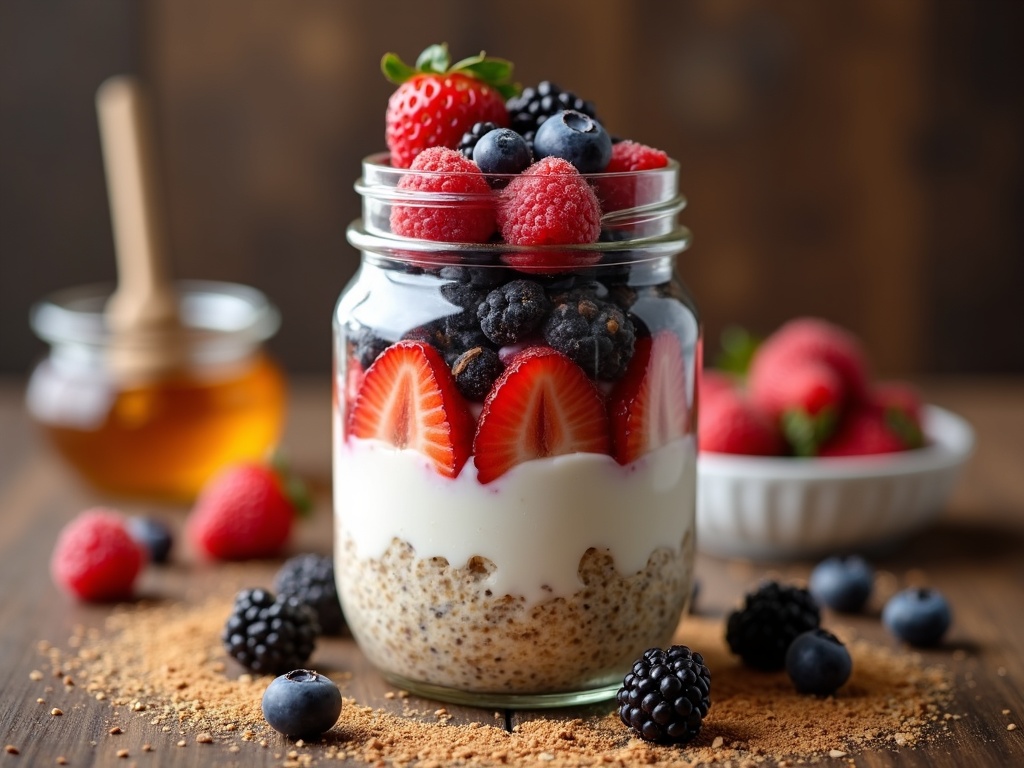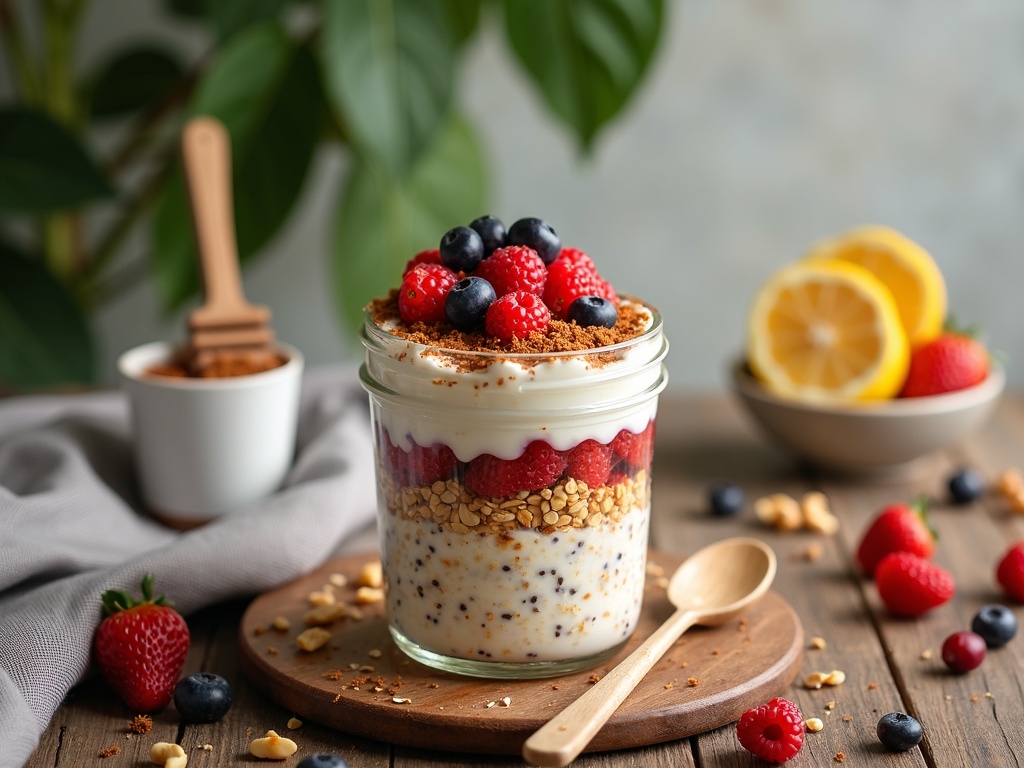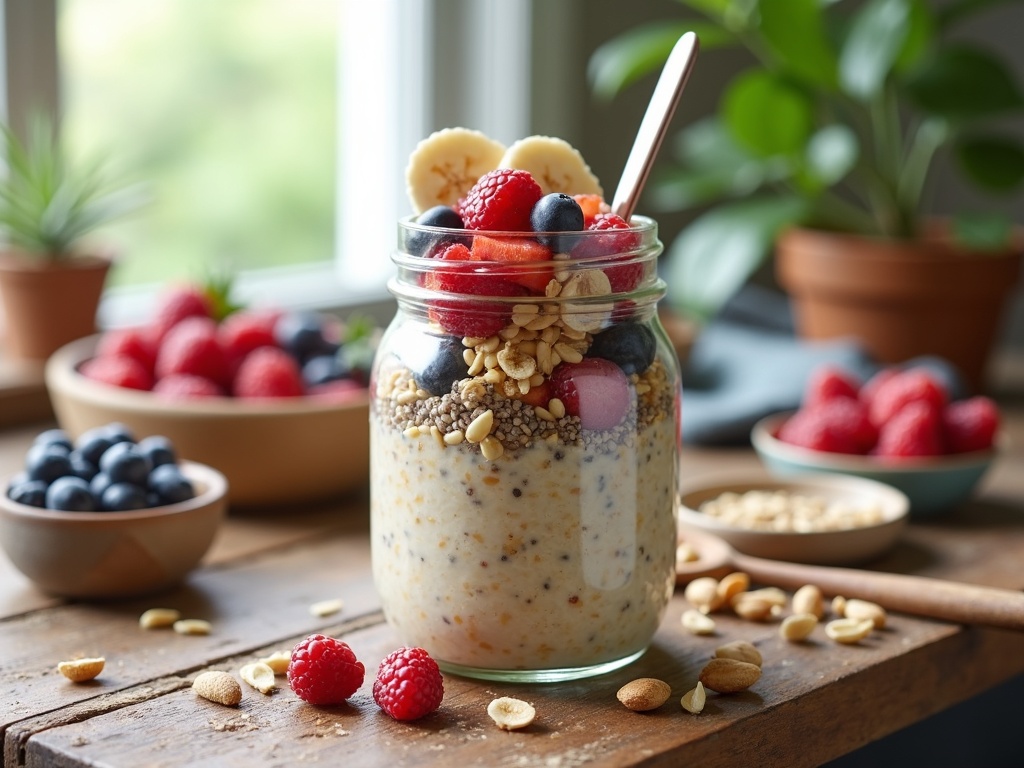Overnight oats stand out as an effective weight loss breakfast option, blending a balanced mix of fiber and protein with incredible preparation flexibility. This ready-to-eat morning meal contains about 150 calories per serving with 5g protein and 4g fiber, creating a filling breakfast that controls hunger throughout the morning and helps maintain healthy weight management.
Find In This Article
Key Takeaways
- The fiber-protein combination in overnight oats helps stabilize blood sugar levels, reduce hunger hormones, and increase the thermic effect of food during digestion.
- Using the proper ratio of two parts liquid to one part rolled oats (never quick oats) ensures the perfect texture after 6-8 hours of refrigeration.
- Adding Greek yogurt or protein powder can boost protein content by up to 15g, enhancing the weight management benefits.
- Portion control is essential—stick to ½ cup dry oats per serving and measure calorie-dense toppings like nuts and nut butters carefully.
- Both sweet variations (like tropical or chocolate peanut butter) and savory options can be customized while maintaining calorie goals for sustainable weight loss.
Why Overnight Oats Support Weight Loss
Overnight oats have become my go-to recommendation for anyone looking to lose weight while still enjoying a delicious and satisfying breakfast. The nutritional profile is impressive – just one serving contains approximately 150 calories, 5g protein, 3g fat, 27g carbs, and 4g fiber. This balance makes it an ideal weight loss breakfast option that keeps you full without adding excessive calories.
The Power of Fiber and Protein
The 4g of fiber in a basic overnight oats serving plays a crucial role in weight management. Fiber slows digestion, helping you feel fuller longer and naturally reducing your calorie intake throughout the day. According to a study in the Journal of Nutrition (2015), high-fiber breakfasts significantly help manage appetite and reduce snacking between meals.
I’ve found that boosting the protein content makes overnight oats even more effective for weight loss. Adding Greek yogurt or a scoop of protein powder can increase the protein content by up to 15g, turning your breakfast into a high-protein weight loss meal. This protein-fiber combination creates the perfect satiety duo that helps:
- Stabilize blood sugar levels to prevent energy crashes
- Reduce hunger hormones that trigger cravings
- Support muscle maintenance during weight loss
- Increase the thermic effect of food (calories burned during digestion)
What makes overnight oats particularly valuable for weight management is their versatility. I can customize them with healthy breakfast additions like berries, cinnamon, or chia seeds without significantly increasing the calorie count. The make-ahead nature also prevents impulsive, calorie-dense breakfast choices when I’m rushed in the morning.
For those who struggle with portion control, overnight oats offer a practical solution. The pre-portioned servings eliminate guesswork, making it easy to maintain a healthy breakfast routine that supports your weight loss goals. This practical approach to weight loss turns a simple breakfast into a powerful tool for sustainable results.
Essential Ingredients for Weight Loss Success
Creating a perfect batch of overnight oats for weight loss requires careful selection of ingredients that offer nutritional benefits while keeping calories in check. I’ve found that the right combination can make a huge difference in both taste and effectiveness for weight management.
The Foundation Elements
Starting with a proper base is critical. I use 1/2 cup of rolled oats as the foundation for my overnight oats. This amount provides enough fiber to keep me full without excessive calories. For those with gluten sensitivities, gluten-free oats work perfectly as a substitute.
The liquid component is equally important – I typically add 1 cup of milk to achieve the right consistency. This can be dairy milk or any plant-based alternative like almond, oat, or soy milk depending on your dietary preferences. Plant-based options often contain fewer calories, making them excellent choices for weight loss breakfast recipes.
Protein is crucial for weight loss success, as it helps maintain muscle mass while keeping hunger at bay. I incorporate protein in two ways:
- A generous dollop of Greek yogurt (about 1/4 cup) adds creaminess and protein
- A scoop of protein powder can boost the protein content even further
- Both options help create a more satiating breakfast that prevents mid-morning snacking
For healthy fats that support weight loss, I always include 1 tablespoon of chia seeds. These tiny powerhouses are rich in omega-3 fatty acids and expand when soaked, adding volume and creating a pudding-like texture that makes the high-protein breakfast more filling.
Flavorful Add-ins and Toppings
The beauty of overnight oats lies in their versatility. I can adjust flavors while maintaining their weight loss benefits. Natural sweeteners like honey, maple syrup, or agave nectar can be added, but I use them sparingly – typically just 1 teaspoon is enough to enhance flavor without adding excessive calories.
Fresh or frozen fruits serve as both flavor enhancers and nutritional boosters. Berries are my go-to choice as they’re lower in sugar than many other fruits while providing antioxidants and essential vitamins. A half cup of mixed berries adds natural sweetness and color to my healthy breakfast creation.
For added crunch and nutritional benefits, I sometimes include optional toppings just before eating:
- A tablespoon of chopped nuts like almonds or walnuts
- A sprinkle of seeds such as pumpkin or sunflower
- A dusting of cinnamon or nutmeg for flavor without calories
These toppings add texture contrast and additional nutrients, though I’m careful with portions as nuts and seeds are calorie-dense despite their nutritional value.
The beauty of this easy healthy breakfast is in its preparation. I simply combine all ingredients in a jar or container, stir well, and refrigerate overnight. By morning, the oats have softened and absorbed the flavors, creating a ready-to-eat meal that supports weight loss goals.
For variety, I rotate between different healthy breakfast options throughout the week – changing fruits, spices, or protein sources keeps breakfast exciting while maintaining the nutritional profile needed for steady weight loss.

Perfect Your Overnight Oats Method
Creating the ideal bowl of overnight oats isn’t rocket science, but getting the proportions right makes all the difference when you’re aiming for weight loss breakfast options. I’ve tested countless combinations and found that mastering the basic formula sets you up for success.
The Foundation Formula
The perfect overnight oats start with the right ratio of ingredients. I always combine oats with liquid in a 2:1 ratio – that’s two parts liquid to one part oats. This ensures your oats soften properly without becoming too soggy or remaining too firm. For a standard serving, I use:
- 1/2 cup rolled oats (never quick oats as they become mushy)
- 1 cup liquid (milk, almond milk, or any plant-based alternative)
- 1/2 cup plain yogurt for protein and creamy texture
- 1 tablespoon chia seeds for an omega-3 and fiber boost
The mixing technique matters too. I make sure to stir thoroughly until every oat is submerged in liquid. This prevents dry patches and ensures even soaking. The container choice isn’t fancy – a mason jar works perfectly, but any container with a tight lid will do the job.
After mixing, I place my oats in the refrigerator for at least 6 hours, though overnight (8-10 hours) yields the best texture. This patient approach transforms the ingredients into a nutritious breakfast that supports weight loss.
Customization for Weight Management
The beauty of overnight oats lies in their versatility. I can easily adjust them to support my weight loss goals without sacrificing taste. Adding protein is essential, which is why I never skip the yogurt component. Greek yogurt particularly boosts the protein content, helping to keep hunger at bay throughout the morning.
Chia seeds aren’t just a trendy addition – they expand in liquid, creating a satisfying fullness while adding minimal calories. Their fiber content slows digestion, providing sustained energy rather than quick spikes and crashes.
I’ve found that preparing these easy breakfast jars in batches saves tremendous time. I make 3-4 jars on Sunday evening, and I’m set for most of the week. Just before eating, I give the mixture a good stir to redistribute any settled ingredients.
The final touch comes with fresh toppings added just before eating. I keep these weight-friendly by choosing:
- Fresh berries instead of dried fruit (lower sugar, higher volume)
- A sprinkle of cinnamon (adds flavor without calories)
- A small handful of chopped nuts for healthy fats and crunch
- A drizzle of honey only if needed (often the fruit provides enough sweetness)
This approach transforms a simple high-protein breakfast option into something I actually look forward to eating. The combination of complex carbs, protein, and healthy fats creates the perfect balance for starting your day on a healthy note.
Remember that consistency is key with overnight oats. The texture improves dramatically when you allow proper soaking time, and having healthy breakfast choices ready eliminates the morning decision fatigue that often leads to poor food choices.

Delicious Weight Loss Variations
I’ve discovered that overnight oats can be incredibly versatile, allowing for both sweet and savory creations that keep your weight loss journey exciting. The beauty of these make-ahead breakfasts lies in their adaptability—you can adjust ingredients to match your taste preferences while maintaining your calorie goals. Let me share some of my favorite variations that have helped me stay on track with my weight loss breakfast plan.
Sweet Flavor Combinations
The tropical variation has become my go-to during summer months. I mix rolled oats with coconut milk instead of regular milk for a rich, creamy texture with a hint of tropical flavor. Then I add fresh pineapple chunks and diced mango, finishing with a light sprinkle of unsweetened shredded coconut. This combination provides natural sweetness without added sugars, making it perfect for a healthy breakfast that supports weight loss.
For chocolate lovers, I’ve perfected a chocolate peanut butter variation that feels indulgent but remains calorie-conscious. I add a tablespoon of unsweetened cocoa powder to my base mixture, along with a measured teaspoon of natural peanut butter. The next morning, I top it with thin banana slices. This combination delivers protein from the peanut butter while satisfying sweet cravings, creating a high-protein breakfast option that keeps me full until lunch.
Don’t be afraid to customize based on seasonal availability. Some winning combinations I’ve tried include:
- Apple cinnamon: diced apples, cinnamon, and a touch of honey
- Berry blast: mixed berries with vanilla extract
- Carrot cake: grated carrots, walnuts, cinnamon, and nutmeg
- Banana bread: mashed banana, walnuts, and cinnamon
Savory Overnight Oats
While sweet variations dominate the overnight oats scene, savory versions offer a refreshing change that can better suit some palates. I start with a base of rolled oats soaked in unsweetened almond milk, adding a pinch of salt and herbs like basil or cilantro. In the morning, I top with diced fresh tomatoes and sliced avocado for healthy fats. This savory approach works wonderfully as part of an easy healthy breakfast routine that breaks the monotony of sweet options.
The key to making these variations support your weight loss goals is portion control and thoughtful ingredient selection. I measure my oats carefully—typically using ½ cup dry oats per serving—and keep toppings within reasonable limits. Nut butters, while nutritious, are calorie-dense, so I stick to 1-2 teaspoons per serving. For natural sweetness, I rely on fresh fruits rather than added sweeteners.
I also rotate between these healthy breakfast options throughout the week to prevent flavor fatigue. This strategy has helped me maintain consistency with my morning routine, which research shows is crucial for sustainable weight loss.
Remember that the perfect overnight oats recipe is the one that fits your specific needs. Don’t hesitate to adjust the liquid ratio, swap ingredients based on what’s available, or create entirely new combinations that align with your best healthy breakfast vision. The flexibility of overnight oats is what makes them such a powerful tool for weight management—providing structure while allowing for the variety that keeps healthy eating enjoyable for the long term.
Common Mistakes to Avoid
Getting my overnight oats recipe right took a bit of trial and error. I’ve learned that small missteps can turn this healthy breakfast into either a disappointing mess or a calorie bomb that won’t help with weight loss goals. Here are the most common pitfalls to sidestep when preparing your healthy breakfast options like overnight oats.
Texture and Preparation Issues
Using quick oats instead of rolled oats is a major mistake I see often. Quick oats absorb liquid too rapidly and create a mushy, baby-food-like consistency that’s far from appetizing. Rolled oats maintain their structure better, giving you that perfect chewy texture that makes best healthy breakfast options so satisfying.
The liquid ratio matters tremendously too. I’ve found that insufficient liquid leads to dry, hard oats that are unpleasant to eat. As a general rule, aim for a 1:1 ratio of oats to liquid, adjusting slightly based on your texture preference. Remember that chia seeds, if you’re using them, will absorb extra liquid.
Skipping the full soaking time is another common error. Overnight oats aren’t called “overnight” for nothing! They need at least 4-6 hours to properly soften and develop flavor. I prepare mine before bed for a ready-to-eat easy healthy breakfast in the morning.
Weight Loss Saboteurs
Adding too many sweeteners can quickly counteract your weight loss efforts. Even natural sweeteners like honey and maple syrup contain considerable calories. I recommend starting with just a teaspoon of sweetener, or better yet, relying on the natural sweetness of fruit toppings for your best breakfast for weight loss.
Toppings are where many people go wrong. It’s easy to get carried away with nuts, seeds, nut butters, and dried fruits – all calorie-dense foods. While these add nutrition, they can quickly turn your high protein breakfast for weight loss into a high-calorie meal. I measure my toppings carefully, using just a tablespoon of nuts or seeds and favoring fresh fruits which add volume and sweetness with fewer calories.
Portion control applies to the base recipe too. Some recipes call for large portions that exceed calorie needs. I stick to a half-cup of dry oats per serving for my healthy breakfast for weight loss, which creates a filling meal without excessive calories.
By avoiding these common mistakes, your overnight oats will not only taste better but also support your weight loss journey more effectively.

Sources:
Journal of Nutrition, 2015
Nutrition Today, 2019
Medical News Today, 2020

